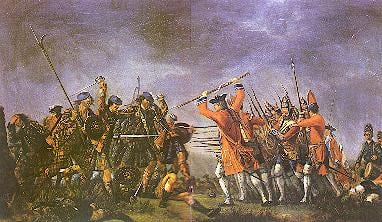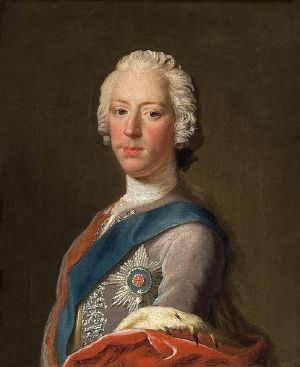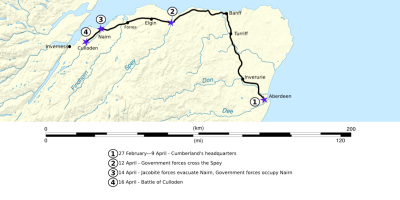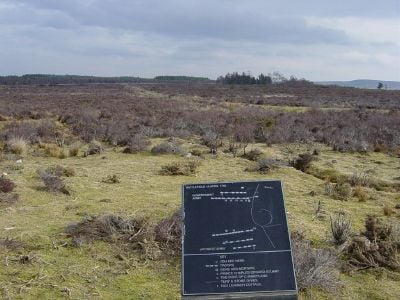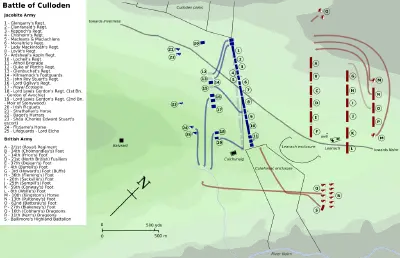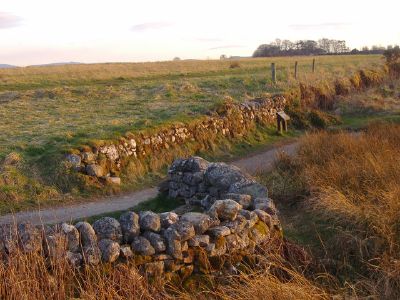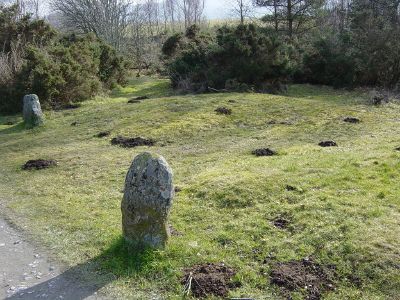Battle of Culloden
The Battle of Culloden (April 16, 1746) was the last military clash ever to be fought on British soil. It was between the forces of the Jacobites, who supported the claim of Charles Edward Stuart (also known as "Bonnie Prince Charlie") to the throne; and the Royal Army, which supported the Hanoverian sovereign, George II of Great Britain. Culloden brought the 1745 Jacobite Rising to a close. It was a decisive defeat for the Jacobite cause, and Prince Charles left Britain and went to Rome, never to attempt to take the throne again.
In fact, the rebellion was small, but it had enormous psychological impact upon the Highland Scots, and severe civil penalties thereafter (for example, it became a criminal offense to wear tartan plaid). What followed can be described as cultural vandalism, with the destruction of a way of life that many had found meaningful, giving them a sense of identity and kinship.
Background
Prince Charles Edward Stuart (1720-88), known to his supporters as "Bonnie Prince Charlie" and to his opponents as the "Young Pretender," successfully raised forces, mainly of Scottish Highland clansmen, which took Edinburgh and defeated the Royal Army stationed in Scotland at the Battle of Prestonpans. The British government began bringing forces back from the war with France in Flanders to deal with the Jacobite rebellion.
After a lengthy wait, Charles persuaded his generals that English Jacobites would stage a rising and the French would invade to assist them. His army of around 5000 invaded England on November 8, 1745, and advanced through Carlisle and Manchester to Derby, a position where they appeared to threaten London, leading King George II to make plans to decamp to Hanover. The Jacobites met only token resistance in England; however, there was also very little active support from English Jacobites, and the French invasion fleet was still being assembled, the armies of General George Wade (later Field Marshall, 1673-1748) and of William Augustus, Duke of Cumberland (1721-1765) were approaching, a militia was forming in London and they had (fictitious) reports of a third army closing on them. The Jacobite general Lord George Murray and the Council of War insisted on returning to join their growing force in Scotland and on December 6, 1745, they withdrew, with the Prince petulantly leaving the command to Murray.
The Jacobite forces reached Glasgow by December 25, re-provisioned, and were joined by a few thousand extra men. They then clashed with the forces of General Henry Hawley (1679-1759), near Falkirk, and were victorious. The Duke of Cumberland arrived in Edinburgh on January 30, to take over command of the government army from General Hawley, then marched north along the coast with the army being supplied by sea. They assembled at Aberdeen and spent six weeks in careful training.
The King's forces continued to pressure Charles, and he retired northwards, losing men and failing to take Stirling Castle or Fort William, but investing Fort Augustus and Fort George in Inverness by early April. Charles now took charge again, insisting on fighting a defensive action.
Armies
Nearly three quarters of the Jacobite army was formed of Scottish Highland clansmen, the majority of them being Roman Catholic but more than a third being Scottish Episcopalians. Only 20-25 percent of the highlanders were armed with swords, some having spears or axes, and the remainder makeshift or captured weapons. Around a quarter of the total force were Episcopalians from the north-east Scottish Lowlands north of the River Tay so that more than half the total was Episcopalian, but the lowland contribution was obscured by their tendency to wear Highland dress as a kind of Jacobite uniform. During the invasion of England, about 300 English Catholics from Manchester formed a regiment, but were left behind for a rearguard action at Carlisle. At the end of November, French ships arrived in Scotland with 800 men from the Ăcossais Royeaux (Royal Scots) and Irish Regiments of the French army. Many of the Highlanders had left for home after Falkirk, and the army was badly provisioned and on short rations.
The British Army under Cumberland, assembled and trained at Aberdeen, was well supplied. It included:
- Twelve battalions of foot which were mostly English. Three regiments of horse and a company of artillery which were mostly English but possibly also included German Hanoverians.
- Three battalions of Lowland Scots foot soldiers; one battalion and a militia had been largely raised from Clan Campbell Highlanders.
- A professional battalion of Highland Scots from Clan Munro who had been fighting for the British in France.
- Other Highland clans that fought on side with the government army at Culloden included the Clan Sutherland, Clan MacKay, Clan Ross, Clan Gunn, Clan Grant, and others. Most of the these clans fought in a regiment under the name of an English officer. For example, Barrel's Regiment of Foot and Cholmondley's Regiment of Foot. Also the Royal Scots Regiment of Foot.
Battle
The Duke of Cumberland and his army of around 8,000 arrived at Nairn on April 14. The Jacobite forces of about 5,400 left their base at Inverness, leaving most of their supplies, and assembled 5 miles (8 km) to the east near Drummossie, around 12 miles (19 km) before Nairn. Prince Charles had decided to take personal command of his forces and took the advice of his adjutant general, Secretary OâSullivan, who chose to stage a defensive action at Drummossie Moor, a stretch of open moorland enclosed between the walled Culloden enclosures to the North and the walls of Culloden Park to the South. Lord George Murray "did not like the ground" and with other senior officers pointed out the unsuitability of the rough moorland terrain which was highly advantageous to the Duke with the marshy and uneven ground making the famed Highland charge somewhat more difficult, while remaining open to Cumberlandâs powerful artillery. They had argued for a guerrilla campaign, but the Prince refused to change his mind.
On April 15, the Government army celebrated Cumberland's birthday, drinking to his health at his expense. At the suggestion of Murray, the Jacobites tried that evening to repeat the success of Prestonpans by carrying out a night attack on the government army encampment, but the half-starved Highlanders who had only had one biscuit apiece during the day were still 2 miles (3 km) short of Nairn by dawn and had to march back, then dispersed to search for food or fell asleep in ditches and outbuildings. Many of them lay exhausted in the grounds of Culloden House throughout the battle.
Early on April 16, the Government army marched from Nairn, and Jacobite guns sounded the alarm (though not all heard) to bring their troops to form two lines. The front line of exhausted highland foot soldiers had guns in the center and on the flanks, the second line included their horse regiments, worn out from the night march, and the Scots and Irish regiments of the French army. The weather was very poor with a gale driving sleety rain into the faces of the Jacobites. The Duke's forces arrived around mid day and arrayed themselves in two lines to face the Jacobite forces, their left flank anchored on a low stone wall running along the south end of the field towards Culloden Park. Horse Dragoons and Government militia moved round behind the wall to infiltrate the park around the Jacobite flank. The Prince's artillery, outnumbered some three to one, opened fire first, but due to a lack of trained gunners had little impact.
Over the next twenty minutes Cumberland's superior artillery continued to batter the Jacobite lines, while Charles, moved for safety out of sight of his own forces, waited for the government forces to move. Inexplicably, he left his forces arrayed under the Government fire for over half an hour. Although the marshy terrain minimized casualties, the morale of the Jacobites began to suffer. Several clan leaders, angry at the lack of action, pressured Charles to issue the order to charge. When he was eventually persuaded to issue the order, the McDonalds refused, angry because they had been placed on the left flank overturning their traditional right to take the right flank. The Clan Chattan was first away, but an area of boggy ground in front of them forced them to veer right so that they obstructed the following regiments and the attack was pushed towards the wall. The Highlanders advanced on the left flank of the Government troops but were subjected to several volleys of musket fire and the artillery which had switched from roundshot to grapeshot.
Despite this, a large number of Jacobites reached the Government lines; however, unlike in previous battles, their uncoordinated charge meant that the line arrived piecemeal. The newly introduced bayonet drill used by the government troops meant that in many places the charge, already flagging, was crushed against the Government lines. Despite this, the right flank of the Jacobites broke through the first line of Government troops and was only halted by Cumberland's second line of defense.
A captain of Munro's regiment later recounted that:
I thank God I escaped free, but my coat has six balls through it. In the midst of this action the officer that led on the Clan Camerons called to me to take quarter, which I refused and I bid the rebel scoundrel advance. He did, and fired at me, but providentially missed his mark. I then shot him dead and took his pistol and dirk.[1]
While the attack was still in progress, a small number of the Government forces had breached the park wall and the Campbell militia advanced unseen to fire at the right flank of the Jacobite lines. This added to all the other brutal gunfire, and threatened by cavalry the Jacobites were forced to retreat. The Duke ordered in his dragoons to rout the Jacobite forces, but the small contingent of elite Irish and other regular regiments covered the retreat as the Jacobites withdrew.
In a total of about 60 minutes, the Duke was victorious, around 1,250 Jacobites were dead, a similar number were wounded, and 558 prisoners were taken. Cumberland lost about 52 dead and 259 wounded among his Government forces.
Aftermath
After their victory, Cumberland ordered his men to execute all the Jacobite wounded and prisoners, an act by which he was known afterwards as "the Butcher." Certain higher-ranking prisoners did survive to be tried and executed later in Inverness.
The Prince fled the battlefield and survived for five months in Scotland despite a ÂŁ30,000 reward for his capture. The Prince eventually returned to France, making a dramatic if humiliating escape disguised as a "lady's maid" to Flora Macdonald.
Immediately after the battle, Cumberland rode into Inverness, his drawn sword still covered in blood, a symbolic and menacing gesture. The following day, the slaughter continued, when patrols were sent back to the battlefield to kill any survivors; contemporary sources indicate that about 70 more Jacobites were killed as a result of this. Cumberland emptied the jails of English prisoners, and replaced them with Jacobite sympathizers. Numbers of the prisoners were brought south to England to stand trial, charged with high treason, with trials taking place at Berwick, York, and London. Executions were conducted on the basis of drawing lots on a ratio of about 1 in 20. In total, 3,470 Jacobites, supporters, and others were taken prisoner in the aftermath of Culloden, with 120 of them being executed and 88 dying in prison; 936 transported to the colonies, and 222 more "banished." While many were eventually released, the fate of nearly 700 is unknown. As well as dealing out summary justice to his captives, Cumberland was equally ruthless with deserters from his own forces found amongst the prisoners, executing 36 of them.
By contrast, with the ruthless treatment shown to many of the captured clansmen, the detachments of Irish soldiers from the French army were permitted to formally surrender, were treated well and eventually returned to France. They were considered as regular soldiers of a foreign ruler and accordingly subject to the normal practices of warfare. The captured Jacobites were regarded as traitors (even if many had had no choice but to follow their clan leaders) and treated accordingly.
The Hanoverian forces' assault on the Jacobite sympathizers continued in the coming monthsâdestroying the clan system with the Act of Proscription disarming them, banning the kilt and the tartan, the Tenures Abolition Act ending the feudal bond of military service and the Heritable Jurisdictions Act removing the virtually sovereign power the chiefs had over their clan. Statute provisions were aimed at proscribing the perceived religion of the Jacobites, Episcopalian (Catholicism was already banned). Government troops were stationed in the Highlands and built more roads and barracks to better control the region, adding to the Wade roads constructed for Major-General George Wade after the Fifteen rising, as well a new fortress at Fort George, to the east of Inverness. The prescribed clan dress of kilt and tartan was, at least officially, only permitted in the Highland regiments serving in the British Army. Anyone suspected of Jacobite loyalty had to take an oath that they possessed no weapons, or tartan, or any type of highland dress. The ban was not lifted until thirty-five years after the battle.
Culloden battlefield today
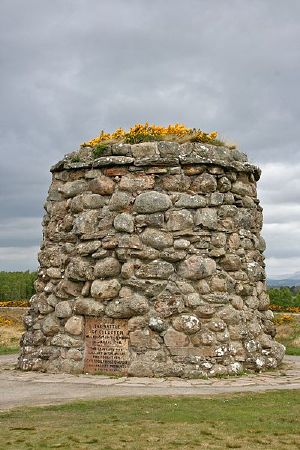
A visitor center is located near the site of the battle. This center was first opened in December 2007, with the intention of preserving the battlefield in a condition similar to how it was on April 16, 1746.
Those visiting can walk the site by way of footpaths on the ground and can also enjoy a view from above on a raised platform. Possibly the most recognizable feature of the battlefield today is the 20Â feet (6.1Â m) tall memorial cairn, erected by Duncan Forbes in 1881.[2] In the same year Forbes also erected headstones to mark the mass graves of the clans. The battlefield has been inventoried and protected by Historic Environment Scotland (formerly Historic Scotland) under the Historic Environment (Amendment) Act 2011.[3]
The National Trust of Scotland is working to restore Culloden Moor, as closely as possible, to the state it was in during the battle. In the intervening years it became covered in shrubs and heather; during the eighteenth century, the area was used as common grazing ground. Today, there are goats and Shetland cows who graze the land just as they would have years ago.
Order Of Battle
Jacobite Army
(approximately 5,400 men)
- Army CommanderâPrince Charles Edward Stuart
- FIRST LINEâ3,810 men
- Right Wingâ1,150 men (Lord George Murray, brother of the Chief of Clan Murray)
- Atholl Highlanders Regimentâ500 men (William Murray Lord Nairne)
- Clan Cameron Regimentâ400 men (Donald Cameron of Lochiel, de facto Chief of Clan Cameron)
- Clan Stewart of Appin Regimentâ250 men (Charles Stewart of Ardshiel, uncle to the Chief of Clan Stewart of Appin)
- Right Wingâ1,150 men (Lord George Murray, brother of the Chief of Clan Murray)
- Centerâ1,760 men (Lord John Drummond)
- Clan Fraser of Lovat Regimentâ400 men (Charles Fraser of Inverallachie)
- Clan Chattan Regimentâ350 men (Alexander MacGillivray of Dunmaglass, Chief of Clan MacGillivray, for Lady Anne Farquharson MacIntosh, "Colonel Anne," wife of the Chief of Clan MacIntosh and Captain of the Clan Chattan Confederation)
- Clan Farquharson Regimentâ250 men (James Farquharson of Balmoral, "Balmoral the Brave," father of "Colonel Anne")
- Clans MacLachlan & MacLean Regimentâ290 men (Lachlan MacLachlan of MacLachlan, Chief of Clan MacLachlan and aide de camp to the Prince, with Charles MacLean of Drimnin as second-in-command)
- Clan MacLeod Unitâ120 men (Malcolm MacLeod of Raasay) - attached to Clans MacLachlan & MacLean Regiment
- Edinburgh Regimentâ200 men (John Roy Stewart)
- Clan Chisholm Regimentâ150 men (Roderick Chisholm of Comar, son of the Chief of Clan Chisholm)
- Centerâ1,760 men (Lord John Drummond)
- Left Wingâ900 men (James Drummond, 3rd Duke of Perth, Chief of Clan Drummond)
- Clan MacDonald of Clanranald Regimentâ200 men (Ranald MacDonald of Clanranald, "Young Clanranald," son of the Chief of Clan MacDonald of Clanranald)
- Clan MacDonnell of Keppoch Regimentâ200 men (Alexander MacDonnell of Keppoch, Chief of Clan MacDonnell of Keppoch)
- Clan MacDonnell of Glengarry Regimentâ420 men (Donald MacDonell of Lochgarry)
- Clan Grant of Glenmorriston Unitâ80 men (Alexander Grant of Corrimony)âattached to Clan MacDonnell of Glengarry Regiment
- Left Wingâ900 men (James Drummond, 3rd Duke of Perth, Chief of Clan Drummond)
- SECOND LINEâ1,190 men (Lt.Col. Walter Stapleton)
- Angus Regiment (Lord David Ogilvy, son of the Chief of Clan Ogilvy)
- 1st Clan Gordon Regiment (Lord Lewis Gordon, brother of the Chief of Clan Gordon)
- 2nd Clan Gordon Regiment (John Gordon of Glenbucket)
- Duke of Perth's Regiment (Unknown)
- Regiment Eccosais Royeaux (Lord Louis Drummond)
- Irish Piquets Regiment (Maj. Summan)
- THIRD LINEâ400 men
- Kilmarnock's Regiment (William Boyd, 4th Earl of Kilmarnock, Chief of Clan Boyd)
- Pitsligo's Regiment (Alexander Baron Forbes of Pitsligo)
- Regiment Baggot (Unknown)
- Lord Elcho's Horse (David Wemyss Lord Elcho, son of the Chief of Clan Wemyss)
- Life Guards (Unknown)
- FitzJames's Horse (Sir Jean McDonell)
- ARTILLERY (Unknown)
- 2 x 2pdr cannon
- 3 x 4pdr cannon
- 3 x 6pdr cannon
- ARTILLERY (Unknown)
Note 1: Of the commanding officers listed above:
- Donald Cameron of Lochiel, de facto Chief of Clan Cameron, was wounded and had to be carried from the field
- Charles Fraser of Inverallachie was mortally wounded
- Alexander MacGillivray of Dunmaglass, Chief of Clan MacGillivray, was killed, with all but three officers of the Clan Chattan Regiment
- Lachlan MacLachlan of MacLachlan, Chief of Clan MacLachlan, was killed
- Charles MacLean of Drimnin was killed, with two of his sons
- James Drummond, 3rd Duke of Perth and Chief of Clan Drummond, was severely woundedâhe was carried from the field, but died on his way to France
- Alexander MacDonell of Keppoch, Chief of Clan MacDonell of Keppoch, was killed
Other persons of note on the Jacobite side to be killed at Culloden were:
- William Drummond of Machany, 4th Viscount of Strathallan
- Robert Mercer of Aldie, an officer in the Atholl Highlanders Regiment
- Gillies Mhor MacBean of Dalmagerry, who led the MacBeans of the Clan Chattan Regiment
Note 2: More clans fought (and died) at Culloden than is apparent from this order of battle.
The Atholl Highlanders Regiment (also known as the Atholl Brigade) was mostly made up of members of Clan Murray, Clan Ferguson, Clan Stewart of Atholl, Clan Menzies, and Clan Robertson.
Also, the clan regiments are not quite as easily defined as their names suggest. Note that:
- In the Clan Cameron Regiment there were also members of Clan MacFie and Clan MacMillan
- The Clan Stewart of Appin Regiment was not only made up of members of Clan Stewart of Appin, but also of Clan MacLaren, Clan MacColl, Clan MacInnes, Clan MacIntyre, and Clan Livingstone
- The Clan Chattan Regiment was mostly made up of Clan MacIntosh, Clan MacGillivray, and Clan MacBean, but also included members of Clan MacKinnon and Clan MacTavish, which were not part of the Clan Chattan Confederation
- The Clan MacDonnell of Keppoch Regiment included, apart from Clan MacDonnell of Keppoch, also Clan MacDonald of Glencoe (also known as Clan MacIan), Clan MacGregor, and Clan MacIver
- Lord Ogilvy's Angus Regiment consisted mainly of members of Clan Ogilvy and Clan Ramsay
- The Duke of Perth's Regiment consisted mainly of members of Clan Drummond
- Kilmarnock's Regiment consisted mainly of members of Clan Boyd
- Pitsligo's Regiment consisted mainly of members of Clan Forbes
- Lord Elcho's Horse consisted mainly of members of Clan Wemyss
Government army
- Army Commanderâ'William Duke of Cumberland
- FIRST LINEâEarl of Abermarle
- Barrel's Regiment of Foot
- Munro's Regiment of Foot
- Royal Scots Fusilier Regiment
- Price's Regiment of Foot
- Cholmondley's Regiment of Foot
- The Royal Regiment of Foot
- SECOND LINEâMaj.Gen John Huske
- Wolfe's Regiment of Foot (Lt.Col James Wolfe)
- Semphill's Regiment of Foot
- Bligh's Regiment of Foot
- Conway's Regiment of Foot
- Fleming's Regiment of Foot
- Howard's Regiment of Foot
- THIRD LINEâBrig.Gen Mordaunt
- Blakeney's Regiment of Foot
- Battereau's Regiment of Foot
- Pulteney's Regiment of Foot
- Royal Artillery
- 10 x 3pdr cannon
- Campbell's Militia (Col. Jack Campbell)
- Cobham's Dragoons
- Kingston's Regiment of Horse
Notes
- â The Battle of Culloden April 16, 1746 Clan Cameron Online. Retrieved April 12, 2022.
- â Raoul Curtis-Machin, The Great Eight at Culloden National Trust for Scotland, April 28, 2021. Retrieved April 12, 2022.
- â Iain Banks and Tony Pollard, Protecting a Bloodstained History Journal of Conflict Archaeology 6(2) (June, 2011): 124-145.
ReferencesISBN links support NWE through referral fees
- Duffy, Christopher. The '45: Bonnie Prince Charlie and the Untold Story of the Jacobite Rising. Cassel, 2003. ISBN 0304355259
- Harrington, Peter. Culloden 1746. London: Osprey, 1991. ISBN 1855321580
- Maclean, Fitzroy. Scotland, A Concise History. Thames and Hudson, 1991. ISBN 0500277060
- Prebble, John. Culloden. Pimlico, 2002. ISBN 978-0712668200
- Prebble, John. The Lion in the North. Penguin Books, 1973. ISBN 0140036520
- Reid, Stuart. Culloden Moor 1746. Westport, CT: Praeger, 2005. ISBN 0275986357
External links
All links retrieved September 20, 2023.
- Culloden National Trust for Scotland.
- A map of the battle, dated 1746.
- Battle of Culloden National Army Museum.
- The Battle of Culloden Historic UK.
- Battle of Culloden British Battles.
- Remembering Culloden by Frances Owen, Historia, April 16, 2021.
- Culloden Battlefield Historic Environment Scotland.
Credits
New World Encyclopedia writers and editors rewrote and completed the Wikipedia article in accordance with New World Encyclopedia standards. This article abides by terms of the Creative Commons CC-by-sa 3.0 License (CC-by-sa), which may be used and disseminated with proper attribution. Credit is due under the terms of this license that can reference both the New World Encyclopedia contributors and the selfless volunteer contributors of the Wikimedia Foundation. To cite this article click here for a list of acceptable citing formats.The history of earlier contributions by wikipedians is accessible to researchers here:
The history of this article since it was imported to New World Encyclopedia:
Note: Some restrictions may apply to use of individual images which are separately licensed.
